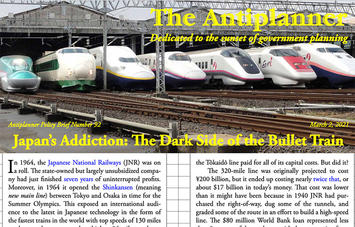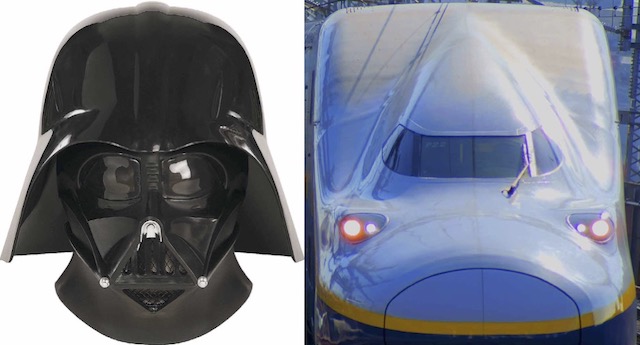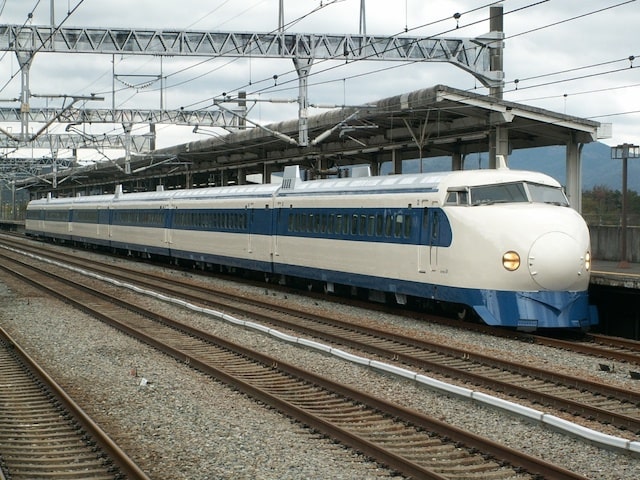
In 1964, the Japanese National Railways (JNR) was on a roll. The state-owned but largely unsubsidized company had just finished seven years of uninterrupted profits. Moreover, in 1964 it opened the Shinkansen (meaning new main line) between Tokyo and Osaka in time for the Summer Olympics. This exposed an international audience to the latest in Japanese technology in the form of the fastest trains in the world with top speeds of 130 miles per hour and average speeds as high as 86 miles per hour. These quickly became the envy of other countries, leading even the United States Congress to pass a law promoting high-speed trains in 1965.
Click here to download the four-page PDF of this policy brief.
Today, salarymen and tourists ride shinkansen the full length of Japan’s main island of Honshu as well as on the outer islands of Hokkaido and Kyushu. However, there is a dark side to the shinkansen. Like Darth Vader, who started out as a nice little boy who loved speed but whose life was corrupted by a power-hungry politician, the shinkansen was warped by politicians and ended up doing more harm than good to Japan’s economy.

Family resemblance? The E4 series train on the right often runs on the Joetsu and Nagano shinkansens, two of the most-expensive and least-used high-speed rail lines in Japan. Photo by Nanashinodensyaku.
Few Profits and Lots of Losses
To help finance the first shinkansen, now known as the Tokaido Shinkansen, JNR borrowed $80 million from the World Bank in 1961 and proudly finished paying off this loan in 1982. Based on this, it is popularly believed that the Tokaido line paid for all of its capital costs. But did it?
The 320-mile line was originally projected to cost ¥200 billion, but it ended up costing nearly twice that, or about $17 billion in today’s money. That cost was lower than it might have been because in 1940 JNR had purchased the right-of-way, dug some of the tunnels, and graded some of the route in an effort to build a high-speed line. The $80 million World Bank loan represented less than 9 percent of the total cost, with the rest coming from bond sales and loans from the Japanese government, particularly through the country’s postal banking system.
While the line carried lots of passengers, it isn’t clear how JNR could have repaid all of these loans as 1963 was the last year in history that it earned a profit. By 1972, it was losing (in today’s money) more than ¥10 billion (roughly $100 million) a year. To counter these losses, JNR repeatedly increased its passenger fares, which only accelerated the shift from rail to automobile travel.
JNR’s losses had several causes, but they all came down to politics. First, JNR operated railways on four of Japan’s islands, but only consistently made money on the main island where more than 80 percent of Japanese live. Japan’s politicians prevented it from shutting down money-losing lines on the outer islands. Second, politicians also prevented JNR from taking advantage of increases in worker productivity, forcing it to keep on its payrolls more than twice as many employees as it needed. Third, the prestige of the Tokaido Shinkansen led politicians in the rest of the country to demand that JNR build shinkansen lines into their prefectures and most of these lines failed to cover their operating costs, much less their capital costs.
Particularly notorious was the Joetsu Shinkansen, which terminates in the city of Niigata on Japan’s northern coast. Being built through mountainous territory, the line cost far more to build than the Tokaido line but carries only one-quarter as many passengers. Built at the behest of Kakuei Tanaka, a member of the Japanese Diet, the line terminates in Niigata, Tanaka’s hometown, whose metropolitan area has only around a million residents. Tanaka was prime minister of Japan for two-and-a-half years before being forced to resign in disgrace and tried and convicted for corruption, accepting bribes, and directing government construction contracts into his prefecture.

The original shinkansen wasn’t called a “bullet train” because it looked like a bullet; instead, it was shaped to look like a bullet to reflect the name bullet train, which had been coined in 1940 long before the trains were designed. Later trains had a duckbill shape aimed at reducing the noise when the trains entered tunnels. Photo by Nadate.
By 1986, JNR and its associated construction companies had racked up more than ¥5 trillion in debts building the Joetsu and other shinkansen lines. JNR also had more than ¥25 trillion in debts due to decades of losing money operating its trains. Along with a few other relatively minor debts, these totaled to ¥32.1 trillion or, in today’s dollars, about $550 billion. On top of this it had ¥5 trillion in unfunded pension obligations.
Read the rest of this piece at The Antiplanner.
Randal O'Toole (rot@ti.org) is a senior fellow with the Cato Institute analyzing land-use and transportation policies and the author of American Nightmare: How Government Undermines the Dream of Homeownership.
Photo: screenshot of report by Randal O'Toole












